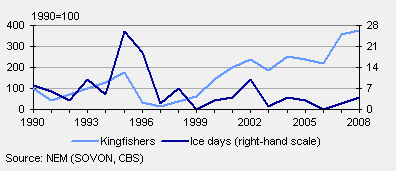Kingfisher threatened by winter cold

Kingfishers dislike freezing weather conditions and even worse, few survive extremely cold winters.
No fish
Ice in winter has far-reaching consequences for the kingfisher population. Ice is in fact the kingfisher’s worst enemy, because, if ditches, pools and lakes are covered with ice, it cannot catch fish. Few kingfishers survive, if most open water bodies are frozen over. After a cold winter it may take years for the population to return to its former level. In peak years, more than 800 couples breed in the Netherlands, in 2008 as many as a thousand, but after an extremely cold winter, as in 1997, the amount of breeding couples may be reduced to no more than 50.
Kingfisher population and ice days

Ice days
Severe winters with many ice days are uncommon in the Netherlands. Since 1900, there have been no more than 12 cold winters. The last cold winter was 1995/1996, when the kingfisher population was decimated. In the next winter, which was also very cold with 19 ice days, the population reached a record low. During the mild winters that followed, the kingfisher population gradually recovered.
In the winter of 2009/2010, 15 ice days were recorded in the period 14 December 2009–27 January 2010. In spring the number of breeding birds will be counted and it will become clear how the kingfisher survived the current winter.
Hibernating birds
Kingfishers are not the only species to have problems surviving in cold winters. In extreme winters, the wren population may be reduced to half. Many bird species are less bothered by cold winters. Hibernating water birds from the north in particular are cold-resistant.
Lodewijk van Duuren (CBS) and Arjan Boele (SOVON)